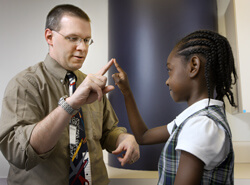NeuroLogic
May 1, 2013

Most of Oakley and Marchand’s patients have nearly daily, primary headaches with no known etiology of tumor, infection, trauma or other causes. For the vast majority, Oakley says, the most important part of his workup is taking a detailed history.
“I spend about 45 minutes talking with each patient,” he says. “If I had my say, I’d probably be spending hours. It’s critical to truly understand each patient and family and build a relationship.”
It’s that solid relationship that makes patients more likely to follow his treatment recommendations on the sometimes-long road to easing chronic headaches, Oakley explains. While researchers are working toward gaining a better understanding of headaches, it’s still unclear what causes them, and there is no cure—only ways to manage the pain and prevent onset.
Working toward that goal, Oakley and Marchand use a three-pronged approach. The team first helps patients attain a healthy lifestyle, complete with maintaining good hydration, getting enough exercise, not skipping meals, eating a healthy diet and getting enough rest. Establishing good habits can help prevent headaches before they start, Oakley says.
Next, based on each patient’s lifestyle, they suggest some alternative therapies, such as physical therapy, meditation, biofeedback and behavioral therapy. “There’s also good evidence that some supplements have benefits,” he says. For example, some of his patients take magnesium, vitamin B2, coenzyme Q10, feverfew and butterbur, all shown to lessen headaches in clinical trials.
Finally, if these approaches don’t significantly reduce the number and severity of a patient’s headaches, Oakley and Marchand prescribe preventive drugs for daily use and abortive drugs for acute headaches.
“I stress to patients and their families that medicines are not a cure. Our best hope is to decrease the headache frequency and severity,” he says. “If we decrease their headaches by 50 percent, that’s a success.”
At the new center, Oakley and Marchand see patients together for the initial visit, and Marchand sees them for follow-up visits, tracking the effects of lifestyle changes and adjusting medicines, if necessary. The team approach allows more access to keep the wait time for appointments shorter and help kids feel better sooner.
“I tell families up front that I don’t focus on how many headaches kids have and what they feel like. I focus on disability and dysfunction,” Oakley says. “I want kids to get back to themselves and feel normal again.”
Information: 410-955-4259
